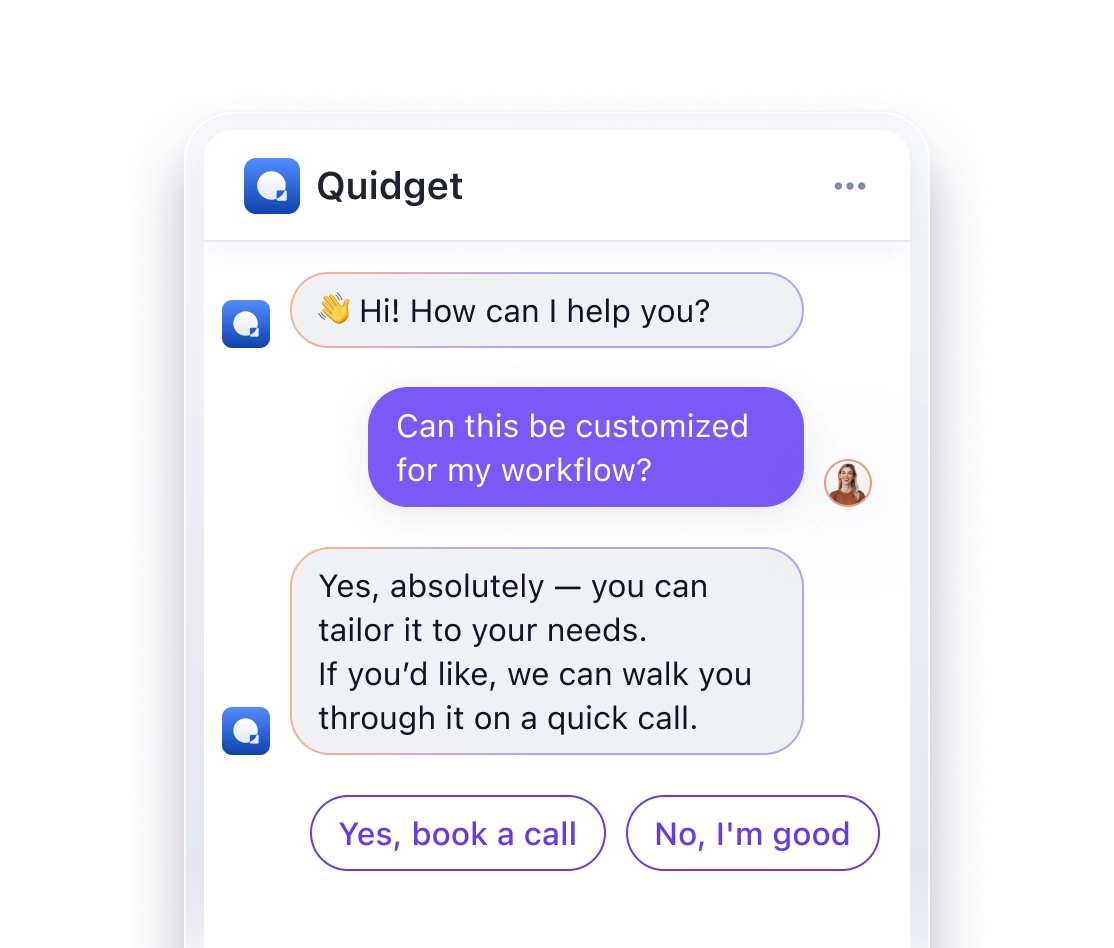The Ultimate Chatbase Comparison Guide: Is It the Best AI Chatbot Builder?
AI chatbot builders are transforming customer interactions. But with so many options, which one is right for you? This guide compares Chatbase with nine other platforms, breaking down features, pricing, and integrations to help you decide.
Key Platforms Compared:
- Chatbase: Easy-to-use interface, custom AI training, starts at $29/month.
- Quidget: No-code builder, supports 45+ languages, starts at $16/month.
- Botpress: Open-source, developer-friendly, starts at $50/month.
- Chatfuel: Focused on Messenger chatbots, starts at $15/month.
- ManyChat: Multi-channel social media focus, starts at $15/month.
- Landbot: Drag-and-drop builder for websites, starts at $40/month.
- Dialogflow: Advanced NLP by Google, pay-as-you-go pricing.
- SnatchBot: Free tier available, supports multiple channels.
- Drift: Website chat for revenue growth, starts at $50/month.
- MobileMonkey: Social media and website focus, starts at $9.95/month.
Quick Comparison Table:
| Platform | Price (Monthly) | AI Features | Channel Support | Best For |
|---|---|---|---|---|
| Chatbase | From $29 | Custom AI Training | Website, API | General use, websites |
| Quidget | From $16 | Advanced NLP | Website, WhatsApp, Slack, Telegram | Multi-channel, global audiences |
| Botpress | From $50 | Developer Tools | Website, custom channels | Developers |
| Chatfuel | From $15 | Basic AI | Facebook, Instagram | Messenger bots |
| ManyChat | From $15 | AI Intents, Steps | Facebook, Instagram, WhatsApp, Email | Social media automation |
| Landbot | From $40 | Limited AI | Website | Web-based chatbots |
| Dialogflow | Pay-as-you-go | Advanced NLP | Multi-channel | Enterprises, developers |
| SnatchBot | Free tier | Basic NLP | Multi-channel | Basic chatbot needs |
| Drift | From $50 | Revenue AI | Website | B2B, revenue-driven businesses |
| MobileMonkey | From $9.95 | Keyword Recognition | Facebook, Instagram, Website, SMS | Social media and website use |
What’s Next?
Dive into the full article to explore detailed features, pricing, and recommendations for each platform. Whether you’re a small business, medium-sized company, or large enterprise, there’s a chatbot builder tailored to your needs.
Top 3 Chatbot Builders Compared: ChatFast vs ChatBase vs …

1. Chatbase Features
Chatbase makes setting up automated conversation tools straightforward with its easy-to-use interface. It’s designed to help users of all skill levels create and deploy chatbots effortlessly.
For more in-depth information on training options, integrations, analytics, and pricing, check out the official documentation.
Now, let’s see how Quidget compares in this area.
2. Quidget Features
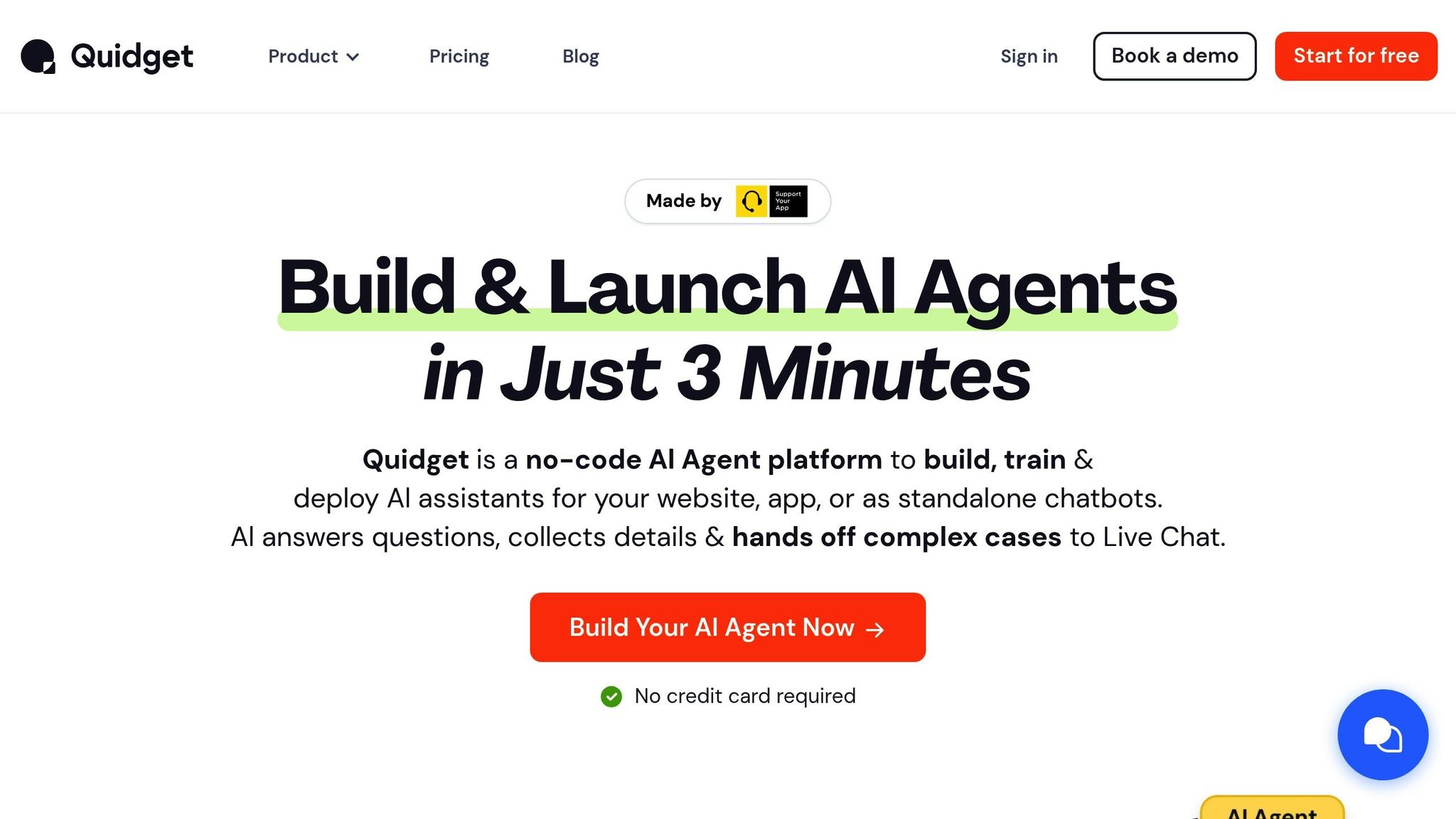
Quidget offers AI-driven tools designed to create smooth and efficient customer interactions. Here’s a closer look at what it brings to the table.
Core AI Capabilities:
- Automatically resolves up to 80% of common customer questions
- Supports over 45 languages, making it ideal for global audiences
- Combines AI with human support for a balanced approach
- Learns and improves automatically through web crawling
Advanced Features:
| Feature Category | Capabilities |
|---|---|
| Training & Setup | • No-code builder • Web crawler for automatic learning • Ready-to-use templates for sales and support |
| Analytics | • Tracks conversations • Measures performance • Provides insights into customer interactions • Analyzes engagement |
Customization Options:
- Fully adjustable widget design to match your website
- Options to align with your brand’s look and feel
- Customizable AI behavior to suit your business needs
Quidget also includes tools to capture leads directly from AI-powered conversations. For businesses of all sizes, pricing starts at $16/month for basic features and goes up to $210/month for enterprise plans, which include 50,000 AI responses per month.
One of its most useful tools is the AI-to-human handoff system. When the AI encounters a complex issue, it automatically transfers the conversation to a human agent, ensuring customers always get the help they need.
3. Botpress Features

Botpress is built with an open-source framework and tools designed for developers. Here’s a breakdown of its main features:
Core Platform Features
| Feature Category | Capabilities |
|---|---|
| Development | – Open-source codebase – JavaScript-based development – Custom code integration – Version control system |
| NLP & AI | – Built-in NLU engine – Intent recognition – Entity extraction – Context management |
| Deployment | – Self-hosted options – Cloud deployment – Multi-channel support – API integrations |
Below is a closer look at these features.
Development Environment
- Visual flow editor for designing conversations
- Code editor for creating custom actions
- Built-in debugging tools
- Flow testing to refine interactions
Natural Language Processing
- Supports multiple languages
- Identifies user intent
- Extracts key information (entities)
- Maintains conversation flow with context awareness
Integration Options
- REST API for custom integrations
- Webhook support for third-party tools
- Connectors for databases
- Compatibility with messaging platforms
Analytics and Monitoring
- Dashboard for tracking conversations
- Metrics on user interactions
- Tools for error tracking and logging
- Performance monitoring
Security Features
- Role-based access control
- Audit logs to track system changes
- Data encryption options
- Tools for managing compliance requirements
4. Chatfuel Features
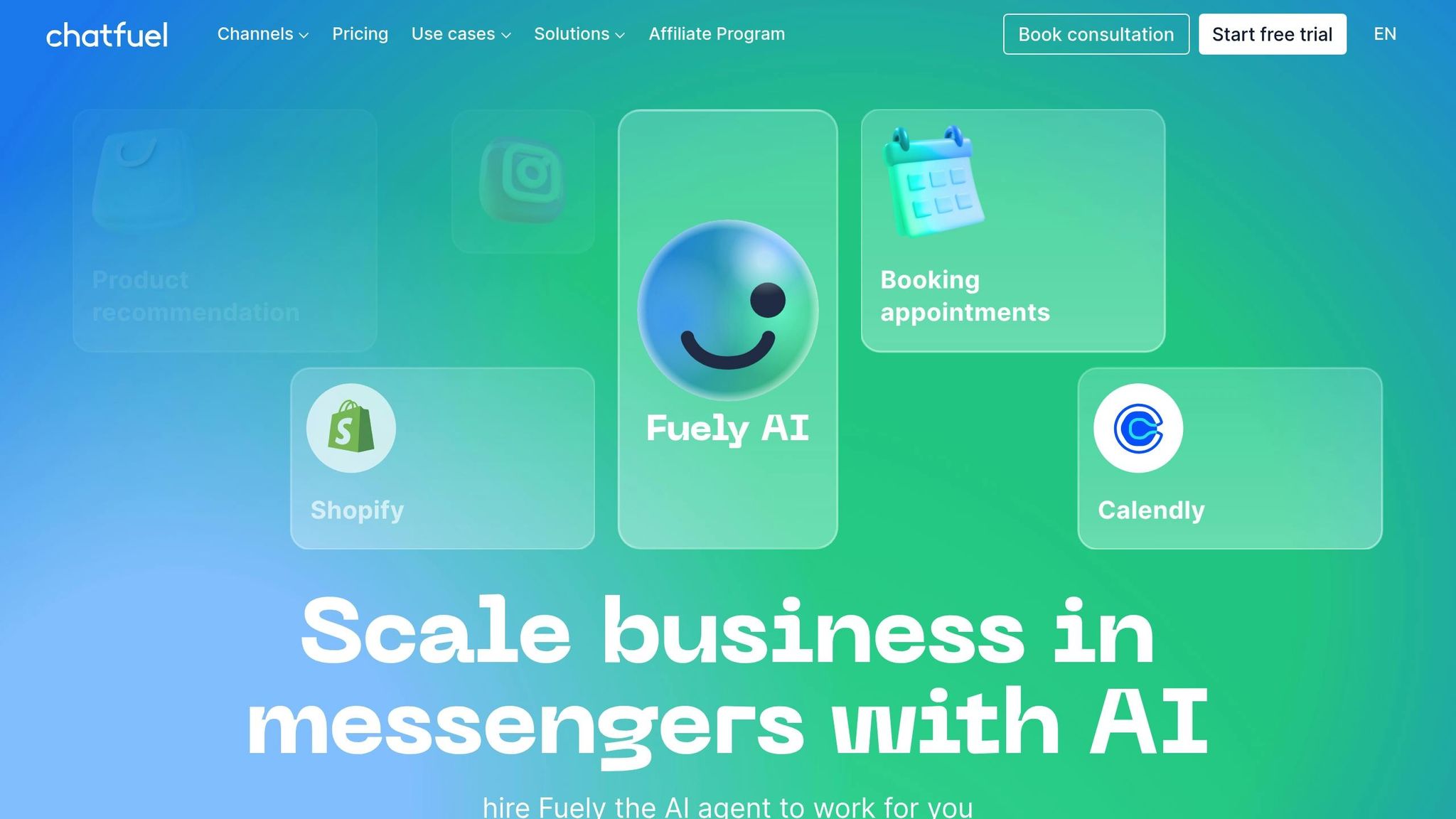
Chatfuel is designed for those without coding experience, featuring a visual flow builder and pre-made templates to simplify creating chatbot conversations. Its intuitive setup allows users to build chatbots quickly and efficiently. Up next, we’ll take a closer look at ManyChat’s tools for automating social media chats.
5. ManyChat Features
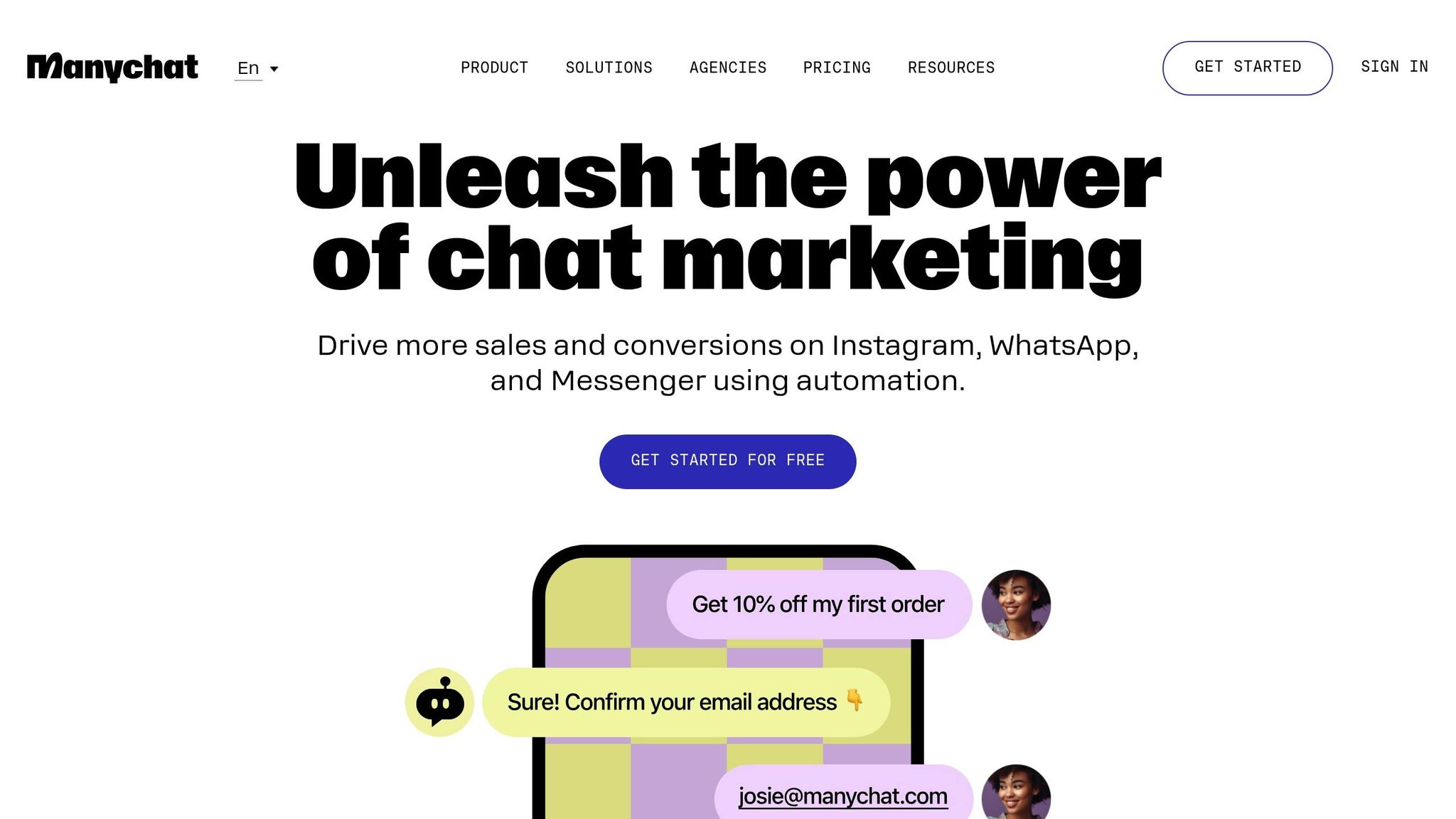
ManyChat goes beyond Chatfuel’s Messenger focus by offering tools for multiple social media platforms. It’s a chatbot builder designed for seamless social media integration and multi-channel messaging. With its Flow Builder, users can create complex conversation flows using a simple drag-and-drop interface – no coding skills required.
The platform supports automation across several channels, including:
- Facebook Messenger
- Telegram
- SMS
ManyChat also includes AI-powered tools such as:
- AI Intents to better interpret user messages
- AI Steps for generating automated responses
- AI Flow Builder Assistant to streamline conversation design
- AI Text Improver to refine message wording
For businesses focused on generating leads and boosting customer engagement, ManyChat provides advanced segmentation options. You can use unlimited custom fields and tags to create highly targeted audiences and run personalized campaigns.
Here’s a closer look at ManyChat’s main features:
| Feature Category | Capabilities |
|---|---|
| Automation Tools | Auto-replies for Facebook/Instagram comments, WhatsApp templates, notifications |
| Team Management | Grouping team members, auto-assigning live chat tasks |
| Analytics | Insights into flow performance, conversion tracking, and agent activity |
| Contact Management | Custom fields, tag-based segmentation, and dynamic user grouping |
The live chat feature is particularly noteworthy, offering tools like team member groups and auto-assignment rules to streamline customer support. Meanwhile, the analytics dashboard provides valuable metrics to help businesses fine-tune their chatbot strategies.
However, ManyChat does not include website chat functionality. If you’re looking for a chatbot specifically for your website, you’ll need to explore other options.
ManyChat delivers a comprehensive multi-channel messaging solution, enhanced by its AI-driven tools for natural and effective conversations.
sbb-itb-58cc2bf
6. Landbot Features
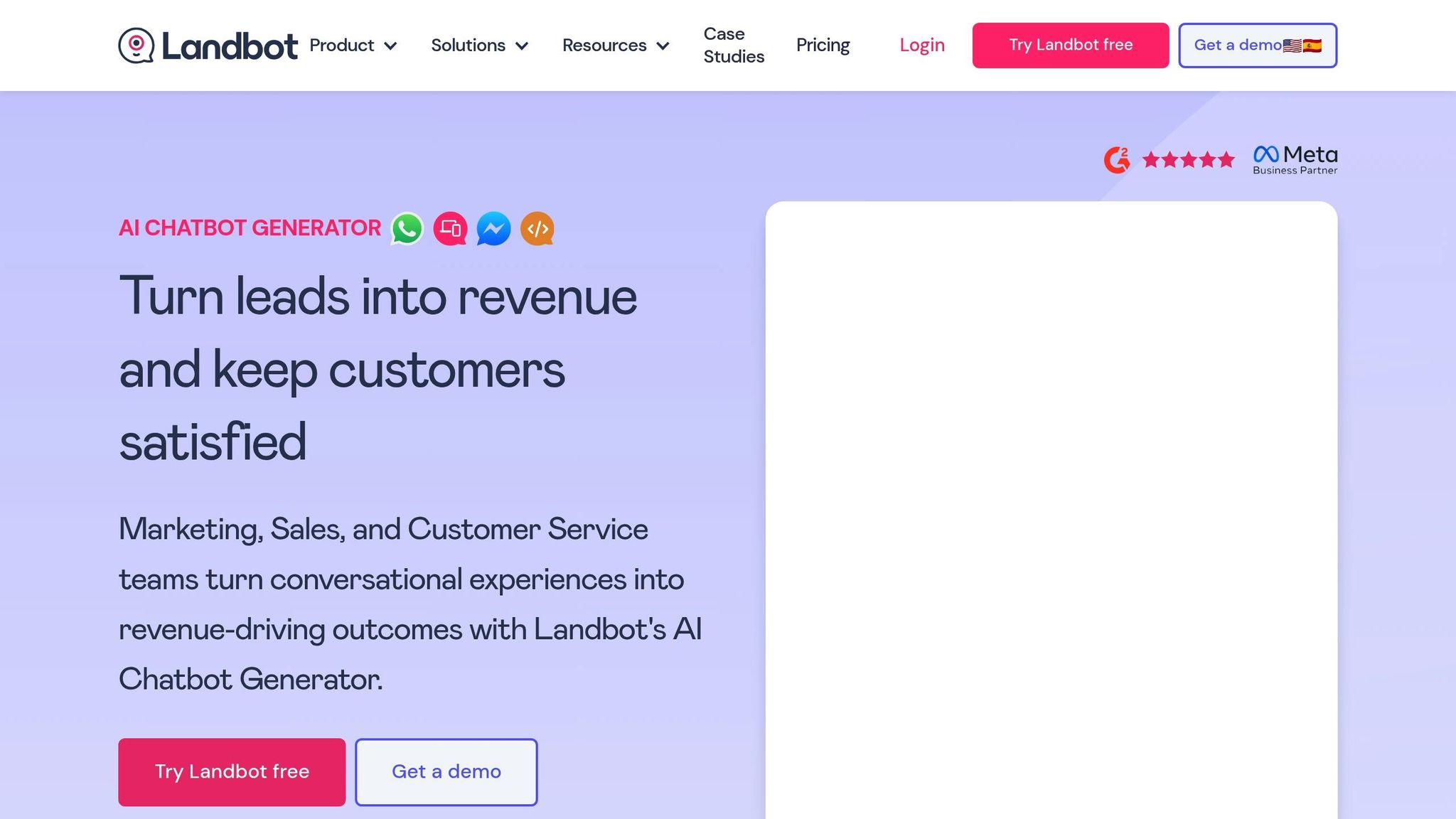
Landbot offers a straightforward drag-and-drop interface that makes building web-based chatbots simple, even for those without coding experience. The platform is designed to create interactive website chatbots with ease.
Here’s a breakdown of its main features:
| Feature Category | Capabilities |
|---|---|
| Visual Builder | Drag-and-drop tools, conditional logic blocks, pre-made message templates |
| Integration Options | Connects with WhatsApp, Facebook Messenger, web chat, and email systems |
| Data Collection | Includes form builders, custom fields, and user data export options |
| Analytics | Tracks conversations, user behavior, and conversion metrics |
| Customization | Offers custom CSS/HTML, brand color settings, and chat widget adjustments |
The visual builder allows users to map out conversation flows using blocks for messages, inputs, logic, and integrations. You can also tweak the chat widget’s size, position, colors, and styling to match your brand identity.
Landbot includes a human handoff feature with smart routing, ensuring smooth transitions for complex conversations. Its built-in analytics provide insights into conversation flows, response times, user engagement, and conversion rates.
One limitation is its AI capabilities. While Landbot performs well with structured, predefined conversation paths, it struggles with handling more complex and open-ended interactions that require advanced natural language processing.
Thanks to its user-friendly design, Landbot is particularly appealing to marketing teams looking to create engaging web chat experiences. Up next, we’ll take a closer look at Dialogflow’s AI strengths.
7. Dialogflow Features
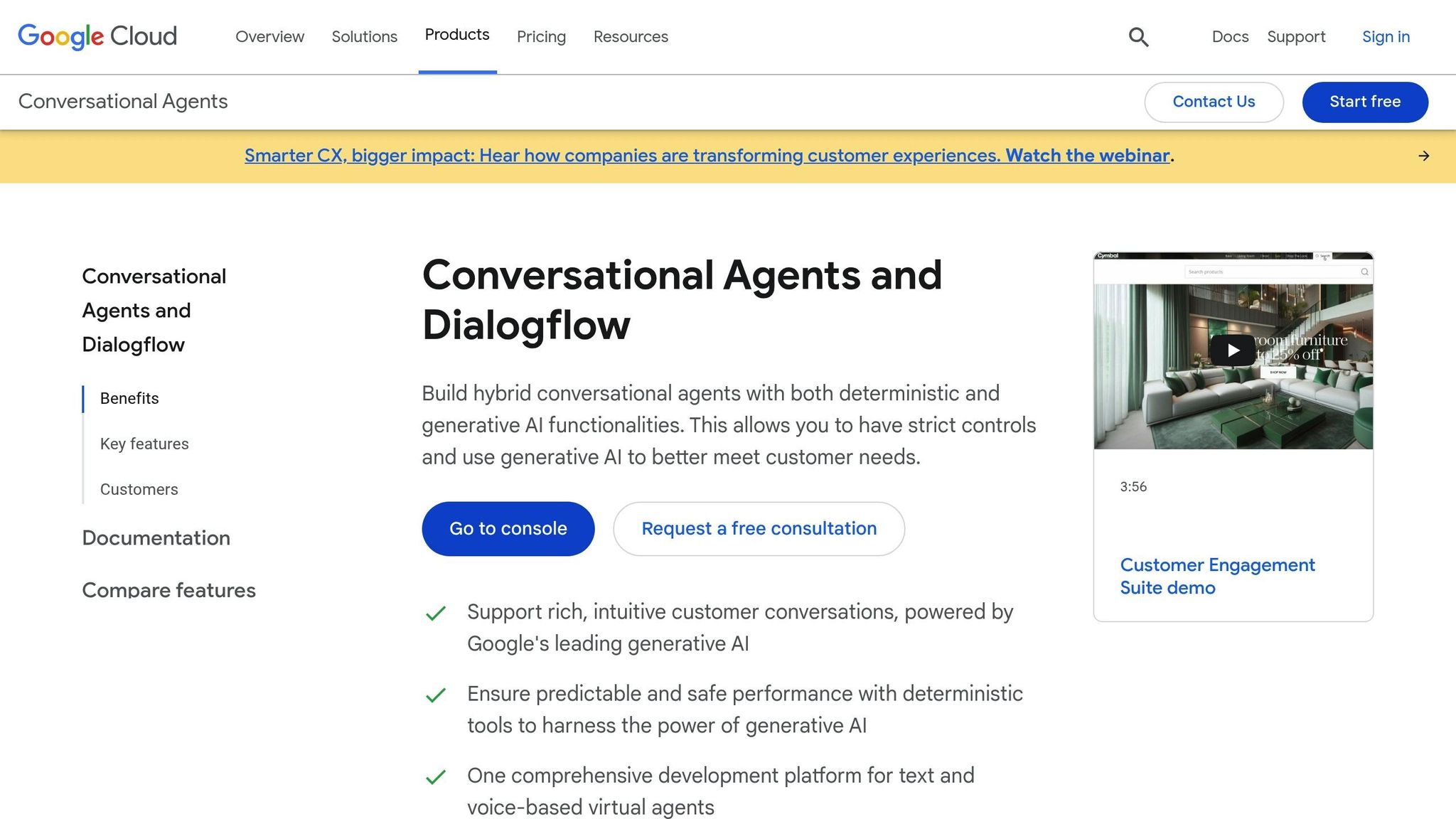
Dialogflow uses Google’s cloud AI to deliver advanced natural language processing (NLP) across various platforms.
| Feature Category | Capabilities |
|---|---|
| NLP Engine | Intent recognition, entity extraction, and context handling |
| Multi-Language | Supports a variety of languages |
| Channel Support | Compatible with Google Assistant, Facebook Messenger, Slack, Telegram, and phone systems |
| Development Tools | Includes pre-built agents, webhook support, and a debugging console |
| Enterprise Features | Offers knowledge bases and speech-to-text functionality |
Dialogflow is highly effective at interpreting user input, even when phrased differently or containing minor errors. Its machine learning capabilities ensure responses improve over time.
The platform can import FAQs and support documents into its knowledge base, automatically generating responses without requiring manual mapping.
Its analytics dashboard provides detailed metrics, such as intent accuracy, session flow, user engagement, response times, and fallback rates. These insights are invaluable when fine-tuning your setup.
However, Dialogflow can be challenging to learn compared to simpler, no-code platforms. Making the most of its custom integrations and advanced conversation flows often requires technical expertise.
For developers, Dialogflow offers robust API access, SDKs, and a testing environment to simulate conversations and verify intents before deployment.
8. SnatchBot Features
SnatchBot offers a no-code platform for building chatbots, making it accessible and ready for deployment across various platforms.
| Feature Category | Capabilities |
|---|---|
| Build Interface | Visual flow builder, drag-and-drop tools, template library |
| Channel Support | Facebook, WhatsApp, Viber, Telegram, SMS, web chat |
| AI Tools | Basic NLP, intent recognition, contextual responses |
| Analytics | Tracks user interactions, conversation flows, and engagement |
| Integration Options | REST API, webhooks, JSON support |
The platform’s interface is designed to be straightforward, focusing on essential features to make chatbot creation easier. It includes pre-built templates for tasks like customer support and lead generation. Its basic NLP capabilities handle intent recognition and keep conversations relevant.
One of SnatchBot’s highlights is its channel management system. After building your chatbot, you can deploy it across multiple platforms without adjusting the core logic. The platform automatically adjusts the interface to fit each channel’s requirements.
The analytics dashboard provides insights into:
- Engagement levels
- Conversation flow efficiency
- Response accuracy
- Peak usage times
For developers, SnatchBot supports webhooks and a REST API for creating custom integrations. It also enables JSON message formatting, which helps exchange structured data with other systems.
However, the platform’s conditional logic is somewhat limited. Handling complex workflows or decision trees might require extra effort or alternative methods.
To ensure smooth operation, the platform includes a testing environment. This feature lets you simulate conversations to catch and fix any potential issues before launching your chatbot.
9. Drift Features
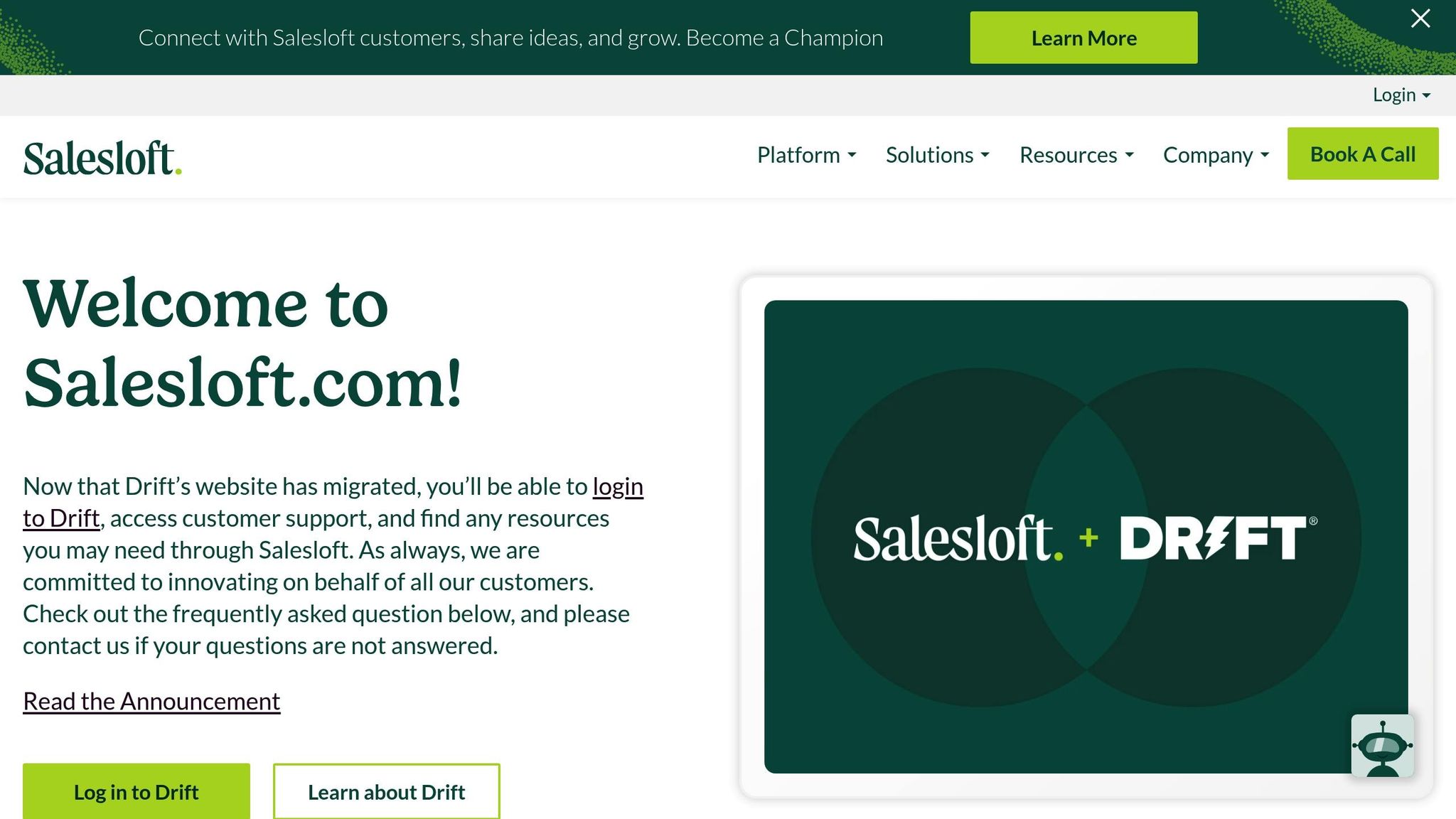
Drift is designed to enhance conversational marketing and boost revenue with its AI-driven website chat solutions.
| Feature Category | Capabilities |
|---|---|
| Conversation Design | Visual builder, conditional logic, custom playbooks |
| AI Capabilities | Intent detection, automated routing, contextual responses |
| Integration Options | CRM systems, marketing tools, sales platforms |
| Analytics Tools | Conversation tracking, revenue attribution, A/B testing |
| Targeting Features | Account-based routing, visitor segmentation, custom rules |
Drift’s conversation builder offers a user-friendly visual interface to design chat flows. With branching logic, it creates dynamic conversation paths based on user responses. Pre-designed templates simplify tasks like lead qualification and meeting scheduling.
Drift’s AI engine powers business conversations by:
- Detecting visitor intent in real-time
- Routing chats to the right team members
- Keeping context throughout interactions
- Automating repetitive tasks and responses
The platform’s targeting system allows precise visitor segmentation. Businesses can set custom rules based on factors like website behavior, traffic source, company size, industry, or location.
The analytics dashboard tracks essential metrics, including conversation volume, response times, conversion rates, meeting bookings, and revenue generated through chat. A/B testing tools help refine messaging, timing, and targeting to improve engagement. These analytics work seamlessly with Drift’s routing features, ensuring smoother customer interactions.
Drift also manages business hours automatically, adjusting chat behavior based on team availability. This ensures appropriate responses, whether staff is online or offline.
Integration is another strong point. Drift connects with popular CRM platforms and marketing tools, ensuring a smooth flow of data between chat interactions and other business processes. Its tools are ideal for businesses looking to turn website visits into revenue.
10. MobileMonkey Features
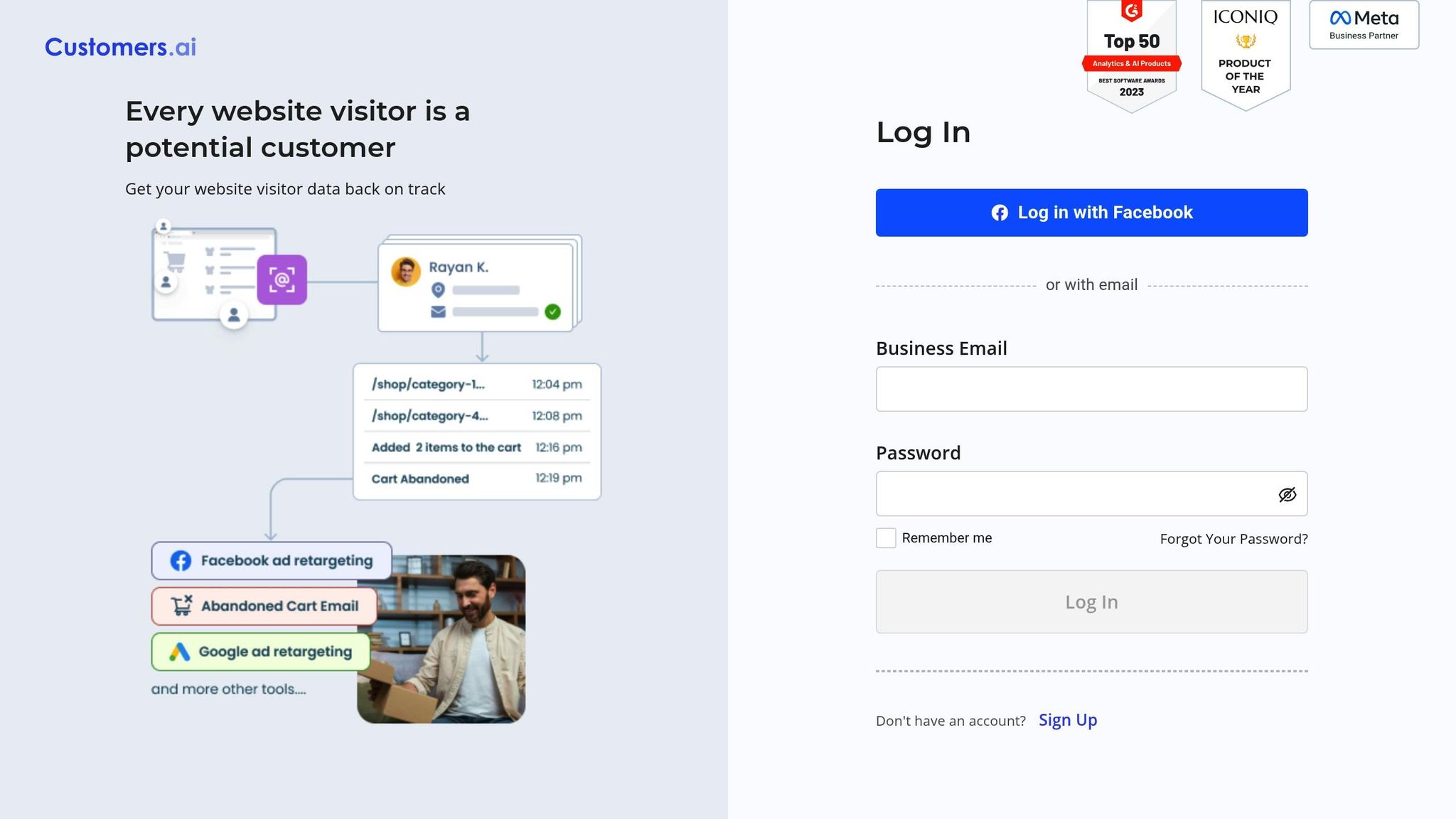
MobileMonkey is a no-code chatbot builder designed for social media and website use. It focuses on multi-channel messaging, covering platforms like Facebook, Instagram, websites, and SMS.
| Feature Category | Capabilities |
|---|---|
| Platform Support | Facebook Messenger, Instagram, Website Chat, SMS |
| Core Functions | Visual Flow Builder, Conditional Logic, User Input Collection |
| Analytics | Basic Dashboard, Unanswered Questions Tracking |
| Live Chat | Standard Agent Interface |
| Integration Options | Limited to Supported Social Platforms |
The tool’s visual flow builder and conditional logic allow businesses to create personalized conversation paths, making it easier to automate lead generation and customer service tasks.
MobileMonkey’s multi-channel setup lets you manage chatbots across Facebook Messenger, Instagram, websites, and SMS – all from a single dashboard. This centralization simplifies communication and ensures consistent messaging.
Its analytics dashboard provides clear insights into chatbot activity, tracking conversations and flagging unanswered questions. This helps businesses adjust their strategies for better engagement. The live chat feature supports direct agent-to-customer communication, though it offers only basic functionality.
For businesses trying out MobileMonkey, there’s a free plan for up to 250 contacts. The Pro plan starts at $9.95 per month.
However, MobileMonkey’s AI capabilities are limited to basic keyword recognition, making it better suited for simple messaging workflows rather than intricate conversations.
The standout feature is its ability to manage multiple social channels from one interface. Plus, the website chat integration lets you extend your chatbot’s reach beyond social media.
Feature Comparison Chart
Here’s a breakdown of key features and capabilities across various AI chatbot platforms.
| Platform | Basic Capabilities | Advanced AI Features | Pricing (Monthly) | Channel Support | Analytics |
|---|---|---|---|---|---|
| Chatbase | Visual Builder, Templates | Custom AI Training | From $29 | Website, API | Basic Dashboard |
| Quidget | No-Code Builder, Templates | AI Agent Training, 45+ Languages | From $16 | Website, WhatsApp, Slack, Telegram | Advanced Analytics |
| Botpress | Open-Source, Code Editor | NLP Training | From $50 | Website, Custom Channels | Developer Tools |
| Chatfuel | Flow Builder | Basic AI | From $15 | Facebook, Instagram | Social Analytics |
| ManyChat | Visual Builder | AI Intents, AI Steps, Text Improver | From $15 | Facebook, Instagram, WhatsApp, Telegram, SMS, Email | Flow Analytics |
| Landbot | Drag-and-Drop | Limited AI | From $40 | Website | Basic Metrics |
| Dialogflow | Developer Tools | Advanced NLP | Pay-as-you-go | Multi-channel | Enterprise Analytics |
| SnatchBot | Template Library | Basic NLP | Free tier available | Multi-channel | Basic Reports |
| Drift | Conversation Builder | Revenue AI | From $50 | Website | Revenue Tracking |
| MobileMonkey | Visual Builder | Keyword Recognition | From $9.95 | Facebook, Instagram, Website, SMS | Basic Dashboard |
Key AI Capabilities Comparison
| Platform | Natural Language Processing | Training Capabilities | Integration Options |
|---|---|---|---|
| Quidget | Advanced NLP | Custom Knowledge Base, FAQs | Zendesk, Calendly, CRM |
| ManyChat | AI Intents, AI Steps | Flow Builder Assistant | Social Platform APIs |
| MobileMonkey | Basic Keyword Recognition | Basic training | Social Media Only |
Pricing Structure Overview
| Platform | Free Plan | Basic Plan | Enterprise Plan |
|---|---|---|---|
| Quidget | 7-day trial | $16/month | $210/month |
| ManyChat | Available | $15/month | Custom Pricing |
| MobileMonkey | Up to 250 contacts | $9.95/month | Custom Pricing |
This chart highlights the differences in functionality, pricing, and channel support. Some platforms excel in multi-channel integration, while others prioritize advanced AI training or analytics.
Integration and Channel Support
| Platform | Website Integration | Social Media | Messaging Apps | API Access |
|---|---|---|---|---|
| Quidget | ✓ | ✓ | WhatsApp, Slack, Telegram | Advanced |
| ManyChat | ✗ | Facebook, Instagram | WhatsApp, Telegram, SMS, Email | Basic |
| MobileMonkey | ✓ | Facebook, Instagram | SMS | Limited |
Summary and Recommendations
Your choice of platform should match your business needs and the communication channels you rely on. Here’s a quick guide to help you decide:
★ Small Businesses & Startups
- Quidget: Offers advanced AI tools and multi-channel support for $16/month.
- ManyChat: Ideal for businesses focused on social media.
- SnatchBot: A good option for those needing basic features.
★ Medium-Sized Businesses
- Quidget Pro: Great for companies requiring advanced AI capabilities.
- Landbot: Perfect if you prefer a drag-and-drop interface.
- Drift: Designed for B2B companies aiming to drive revenue.
★ Enterprise & Large Organizations
- Dialogflow: Best for those with development resources.
- Quidget Enterprise: Handles large-scale AI interactions.
- Botpress: Ideal for organizations needing open-source solutions.
Channel-Specific Recommendations
| Business Need | Best Platform | Why Choose It |
|---|---|---|
| Website Integration | Quidget | Advanced AI with support for 45+ languages. |
| Social Media Focus | ManyChat | Excellent integration with Instagram and Facebook. |
| WhatsApp Business | Quidget/ManyChat | Both offer robust WhatsApp integration. |
| Multi-Channel | Quidget | Works seamlessly with website, WhatsApp, Slack, and Telegram. |
When selecting a platform, consider your communication channels, technical skills, expected conversation volume, and integration requirements. This will ensure you choose the best fit for your business.



